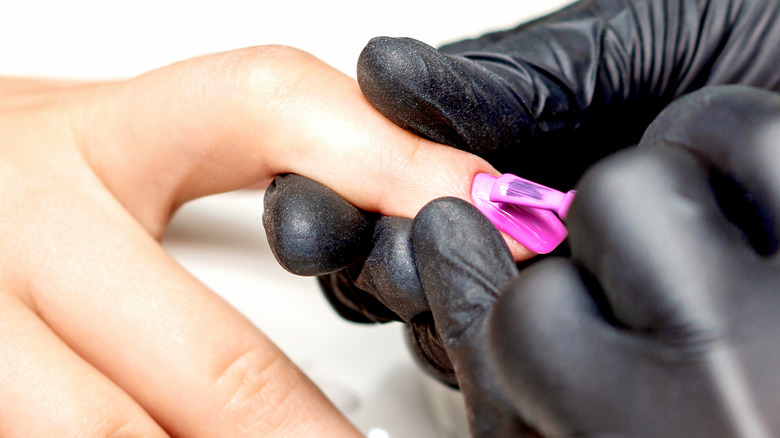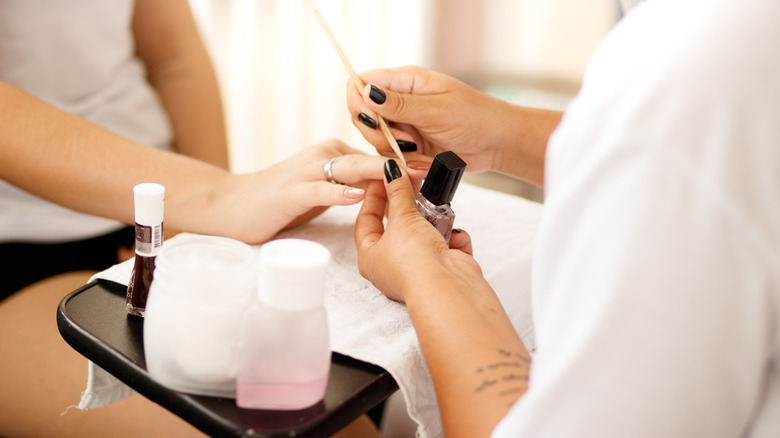What's The Difference Between Regular And Breathable Nail Polish?
When it comes to manicures and pedicures, it's a great time to be alive. Not only have designs and nail art come a long way — just think of that fun 3D charm nail trend — but so have the products that are being used. Our parents' generation didn't have much to choose from when it came to mani-pedis, but luckily for us, we've legit got the world at our fingertips.
One of those big differences that's been making the rounds is breathable nail polish, as opposed to traditional nail polish. From the get-go, anything that's "breathable" sounds like it's probably the best option, but do nails even need to breathe? Well, not in the way we do. "[Nails] derive oxygen and nutrients from the blood supply and not the air," New York City-based dermatologist and nail expert, Dana Stern, told Allure.
But while our nails don't need oxygen, they can use some hydration, something that — in addition to oxygen — can permeate the nail with breathable polish. "Nail cells expand and contract as they absorb and hold moisture, which makes nail polish split, chip, and peel, so we created the Breathable formula to be more permeable than our traditional nail lacquer," VP of Business Development at ORLY International, Tal Pink, told Byrdie. While that's definitely a bonus difference, it's not the only reason you may want to consider breathable nail polish.
Benefits of breathable nail polish
Not only does breathable nail polish prevent waterlogged nails and nail beds, but they have fewer chemicals. You may not realize it, but traditional polish contains some major toxic chemicals: formaldehyde, camphor, and toluene. In fact, when you buy polish that's labeled 3-Free, it's this toxic trio that they're referencing. According to Harvard Medical School, formaldehyde has potential cancer-causing properties, and even if it doesn't cause cancer in someone, it can lead to contact dermatitis, as can toluene. Camphor, too, isn't the type of chemical you want anywhere near you because it's toxic if ingested. Granted, people aren't likely to down a bottle of nail polish, but over a lifetime of manicures, you never know how things will add up in your body.
Breathable nail polish also dries faster and lasts longer. Thanks to that aforementioned ability to let moisture pass through naturally, you don't have to worry about unsightly nail polish chipping or cracking too soon after your manicure. If you're a practicing Muslim, breathable nail polish is wudu-friendly, in that it can be worn during prayer because it doesn't prevent water from passing through the nail.
Should you ditch your traditional polish?
What you choose to do regarding the nail polish that you use is your choice. "Nail polish is essentially paint," founder of Bare Hands, Suzanne Shade, told Healthline. "If you think of it in terms of household waste, all paints (liquid or dried) are classified as toxic substances and cannot be safely put in public landfills — regardless of being labeled 'non-toxic.'" Even when companies say they've swapped out certain ingredients for healthier, earth-friendly options, you never really know what you're going to get. "The challenge is that none of the 'swaps' for plasticizers or binding agents have been studied," added Shade. "So, unfortunately, a lot of folks assume a certain level of safety that just hasn't yet been proven."
The best thing you can do is take this information and decide what makes sense for you. If you're prone to contact dermatitis or cancer runs in your family, then you probably want to ditch the traditional polish. If you figure the planet is on fire, so you don't really have any major concerns about toxic substances being on your hands and possibly getting into your bloodstream, then keep things traditional. As long as you're at peace with your choices, that's all that matters. In the iconic words of Charlotte York, "I choose my choice." In other words, you do you.


